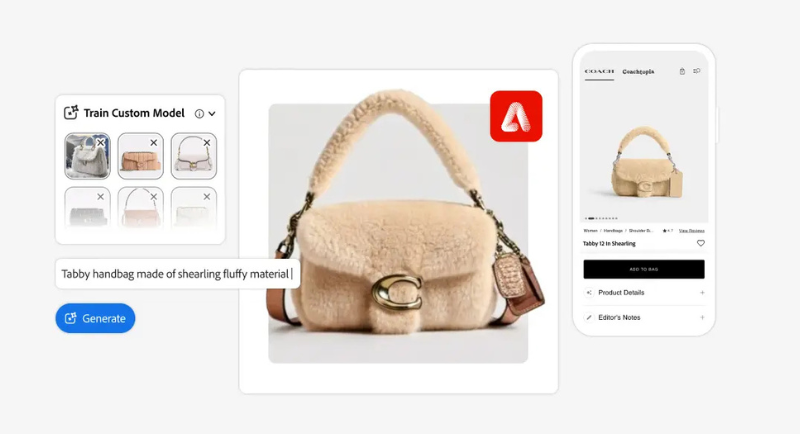Tapestry, the parent company behind brands such as Coach, Kate Spade New York, and Stuart Weitzman, has embraced the generative AI through Adobe Firefly as the digital twin trend grows.
The concept of a digital twin, a virtual replica of a physical product such as outerwear or accessories, is becoming popular as a way to enhance the product development cycle.
Teams can experiment with new concepts while bringing in direct consumer feedback, created through a mix of photoshoots and CAD technical drawings.
To meet this growing demand, Tapestry uses generative AI through Adobe Firefly—a commercially-safe family of creative generative AI models—by training Firefly with their proprietary assets and creating a custom model. This means that when text prompts are used to generate a new image with Firefly, the generation will match the brand’s identity.
The team had a breakthrough moment when an initial test of their Firefly Custom Model produced tailored digital twins that accurately mirrored products already seen on store shelves. It was a major unlock for the company that provided them a way to scale a critical internal service—allowing teams to better ideate and deliver products that resonate with customers.
Adobe Firefly Custom Models enable brands to create content that is unique to their campaign and brand style. By design, Firefly is strictly trained to exclude any asset that touches a brand’s proprietary IP. With Custom Models, brands can fine-tune the Firefly models by training it with their own IP.
The Tapestry team gathered a set of images of existing Coach handbags and used them for training single-concept models for each bag, object, and style. It allowed Adobe Firefly to ingest different “Coach Codes,” which are design components such as the iconic hang tag or nuances around materials and hardware.
In the early test mentioned previously, the team used the prompt “tabby handbag made of shearling fluffy material” (the Coach Tabby bag, launched in 2019, has become one of the most popular handbags for the company). Firefly generated an image that stunned the team: the custom model was able to produce a virtual replica that looked nearly identical to a Tabby bag variation that was currently in the market.
Digital twins are widely used across teams at Tapestry. For instance, they are shown in focus groups to gather direct consumer feedback that informs the product. The Strategy and Global Visual Experience teams also use digital twins to scale content for everything from social media campaigns to in-store merchandising.
When their data science is enhanced with digital twins, teams can extract knowledge and insights that can be used to inform decisions and predictions on how they create, make, and sell products. By tapping customised models, the team will be better equipped to fulfil the insatiable demand, without any sacrifice to quality or consistency.
The rollout of Firefly Custom Models will enable new opportunities in the design process as well. Generative AI allows product designers to experiment with new concepts or to take advantage of cultural trends. And with customised models, designers can create variations while maintaining the core creative vision. They simply put their ideas into a text prompt and generate new images that become a starting point in the production process. It opens new creative avenues and allows the team to design at the speed of their imaginations.
Building support and managing change
“At Tapestry DPC, we understood the potential for generative AI to alleviate the bottlenecks that were preventing us from scaling our digital twins, but we needed a trusted partner that was reliable and ethical in their approach to the technology,” said J.J. Camara, senior director of digital product creation, Tapestry.
“We have a long relationship with Adobe, and our teams love their design tools. We felt confident in what Adobe Firefly could generate, and the result from our customised model will dramatically change how we support our brands from concept to consumer.”
The generative AI space has advanced rapidly, and as it makes its way through different industries, change management has become an important piece of the puzzle. The Tapestry team made a deliberate effort in the beginning to understand both the needs of stakeholders, as well as any hesitation individuals may have had about the technology.
This informed what was presented back to the organisation, including the selection of a trusted technology partner that many were already familiar with. And once people saw the quality of output (with the Tabby handbag), the team was able to seal the deal and rally the company around a new approach.
With the internal validation, Tapestry is now embracing Firefly Services as well—a collection of creative and generative APIs and services for enterprises—to augment other processes including automating the manual steps that are involved in creating images for internal merchandising portals.
